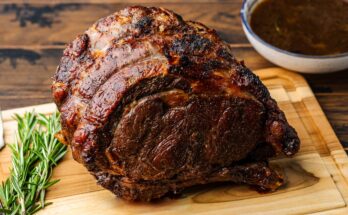Pork Tenderloin Marinade Recipe: If you’ve ever wondered how to turn a simple piece of pork tenderloin into a mouthwatering, juicy masterpiece, the secret lies in one word—marinade. A well-balanced pork tenderloin marinade can transform an ordinary dinner into a restaurant-worthy meal. The beauty of this recipe lies in its simplicity: a few staple pantry ingredients, a touch of creativity, and the patience to let the flavors work their magic.
Marinating not only tenderizes the pork but also infuses every bite with deep, savory notes. Whether you’re planning a quick weeknight dinner or a festive weekend barbecue, this pork tenderloin marinade recipe will become your go-to. In this guide, you’ll learn everything from the science behind marination to how to mix, store, and cook your marinated pork to perfection.
This isn’t just another recipe—it’s a step-by-step manual for elevating your home cooking game. Ready to create tender, flavorful pork that melts in your mouth? Let’s dive in!
Understanding Pork Tenderloin
Before you start mixing your marinade, it’s essential to understand the star of the dish—pork tenderloin. This lean, boneless cut comes from the muscle that runs along the backbone of the pig. It’s naturally tender, which makes it ideal for marinating and quick-cooking methods like roasting or grilling.
Many people confuse pork tenderloin with pork loin, but they’re quite different. Pork loin is thicker, larger, and takes longer to cook, while tenderloin is slender, shorter, and cooks quickly. Because tenderloin is lean, it can dry out easily if overcooked, which is why marinating is so important—it adds moisture, flavor, and tenderness.
Another reason pork tenderloin is perfect for marinating is its texture. The mild flavor of the meat absorbs seasonings and acids beautifully, allowing spices, herbs, and oils to penetrate deeply. This means even a short marination time—around 30 minutes to a few hours—can significantly enhance the final taste.
So, when you choose pork tenderloin, you’re already setting yourself up for success: a lean, healthy, and delicious protein that takes well to all kinds of marinades, from sweet and tangy to spicy and smoky.
Benefits of Marinating Pork Tenderloin
Marinating does more than just flavor your meat—it’s a culinary magic trick that transforms texture and tenderness. Here’s why marinating your pork tenderloin is a game changer:
1. Flavor Infusion: A marinade works by soaking the meat in a mixture of acids (like vinegar, lemon juice, or wine), oils, and seasonings. The acid breaks down tough muscle fibers, allowing flavors to penetrate deeply. Imagine biting into pork that’s juicy on the inside and caramelized on the outside—pure perfection.
2. Enhanced Tenderness: The right combination of ingredients can help tenderize pork even further. For example, soy sauce and vinegar not only season but also soften the meat fibers, giving you that melt-in-your-mouth texture.
3. Retained Moisture: Marinades that include oil or yogurt help lock in moisture during cooking. This prevents the pork from drying out, especially when grilled or roasted at high heat.
4. Flexibility: You can experiment endlessly—sweet, spicy, tangy, or herby—the choice is yours. It’s the ultimate customizable recipe.
How Long to Marinate: Ideally, marinate pork tenderloin for at least 2 to 4 hours, but overnight (up to 12 hours) delivers the deepest flavor. Avoid marinating for more than 24 hours, as the acids can start breaking down the meat too much, giving it a mushy texture.
In short, marinating isn’t just about adding taste—it’s about creating an experience that excites your taste buds with every bite.
Ingredients You’ll Need
Before you start, make sure your kitchen is stocked with the right ingredients. This pork tenderloin marinade combines savory, sweet, and aromatic notes for the ultimate balance.
Core Marinade Ingredients
- 1/4 cup soy sauce – for saltiness and umami richness
- 2 tablespoons olive oil – adds moisture and helps flavors stick
- 2 tablespoons brown sugar or honey – adds a touch of sweetness and helps with caramelization
- 3 cloves garlic, minced – brings out that irresistible aroma
- 1 tablespoon Dijon mustard – adds tanginess and depth
- 1 tablespoon apple cider vinegar or lemon juice – tenderizes the meat
- 1 teaspoon black pepper – for a subtle kick
- 1 teaspoon smoked paprika – enhances smoky notes (especially for grilling)
Optional Add-Ons for Extra Flavor
- Fresh herbs (rosemary, thyme, or parsley) for fragrance
- Chili flakes or hot sauce for spice lovers
- Soy-ginger twist: Add grated ginger for an Asian-inspired profile
- Citrus zest (orange or lime) for brightness
Ingredient Substitutions and Variations
- Substitute tamari or coconut aminos for soy sauce to make it gluten-free
- Swap maple syrup for honey for a richer sweetness
- Use balsamic vinegar for deeper, tangier flavor
This balance of salt, acid, fat, and sweet ensures that your marinade enhances every bite of pork without overpowering it.
Step-by-Step Guide to Making the Perfect Marinade
Let’s get to the fun part—mixing and marinating! Follow this step-by-step guide to create the perfect pork tenderloin marinade.
Step 1 – Gather All Ingredients
Before you start, lay everything out on your kitchen counter. This helps keep the process smooth and prevents missed ingredients. You’ll need a bowl, whisk, measuring spoons, and a zip-lock bag or airtight container for marinating.
Step 2 – Prepare the Marinade Base
In a medium bowl, add soy sauce, olive oil, brown sugar (or honey), Dijon mustard, minced garlic, vinegar, and black pepper. Whisk them together until the sugar dissolves and the mixture is well combined. You’ll notice a glossy, aromatic liquid forming—that’s your flavor base.
Step 3 – Combine and Mix Properly
Add any optional ingredients you like (herbs, chili flakes, ginger, etc.) and mix well. Taste the marinade—it should be balanced, with a perfect harmony of salty, sweet, and tangy. Adjust as needed.
Step 4 – Marinate the Pork Tenderloin
Place your pork tenderloin in a zip-lock bag or container. Pour the marinade over it, seal tightly, and make sure the meat is fully coated. Massage gently to distribute flavors evenly. Place it in the refrigerator for at least 2–4 hours (overnight for best results). Turn it occasionally for even coverage.
Step 5 – Cooking or Grilling the Marinated Pork
Once marinated, remove the pork and let it sit at room temperature for 20–30 minutes before cooking. This helps it cook evenly. Discard any used marinade (don’t reuse it). You can now roast, grill, or sear your pork until it reaches an internal temperature of 145°F (63°C). Let it rest for 5–10 minutes before slicing.
The result? Juicy, flavorful pork tenderloin that’s perfectly balanced in taste and tenderness.
Best Cooking Methods for Marinated Pork Tenderloin
Now that your pork tenderloin is beautifully marinated and ready, let’s talk about cooking methods. Choosing the right cooking method can make or break your dish. The goal is to achieve that golden-brown crust on the outside while keeping the inside juicy and tender. Here are the top three ways to cook your marinated pork tenderloin to perfection.
Oven Roasting
Oven roasting is one of the most reliable ways to cook marinated pork tenderloin because it allows for even heat distribution and helps lock in those rich flavors.
How to Do It:
- Preheat your oven to 400°F (200°C).
- Remove the pork from the marinade and pat it dry with paper towels. (This helps it brown better.)
- Place it on a baking sheet lined with parchment paper or in a roasting pan.
- Roast for 20–25 minutes, depending on the thickness of your pork.
- Check the internal temperature with a meat thermometer—it should read 145°F (63°C) for perfect doneness.
- Let the pork rest for about 10 minutes before slicing to allow the juices to redistribute.
Pro Tip: Brush the tenderloin with a little reserved marinade (not the used one) or honey in the last five minutes for a glossy, caramelized finish.
Oven roasting gives you that tender, evenly cooked pork with just the right balance of crisp edges and moist center—a foolproof method for home cooks.
Grilling
If you’re aiming for a smoky, summer barbecue vibe, grilling is your best friend. Grilling enhances the flavor of the marinade, giving it a slightly charred, irresistible taste.
How to Grill It:
- Preheat your grill to medium-high heat (around 375°F or 190°C).
- Lightly oil the grill grates to prevent sticking.
- Place the marinated pork tenderloin on the grill.
- Grill each side for 4–5 minutes, rotating occasionally for even cooking.
- Lower the heat, cover, and continue to cook for another 10–12 minutes.
- Use a thermometer to ensure the internal temperature reaches 145°F (63°C).
Pro Tip: For an extra punch of flavor, baste the pork with fresh marinade during the last few minutes of grilling (use a fresh batch, not the one used for marinating).
Grilling not only brings out smoky flavors but also adds those classic grill marks that make your dish look as good as it tastes.
Pan Searing
Pan searing is the quickest way to get a flavorful crust and a tender inside—perfect for a weeknight meal when you want something delicious without firing up the grill or oven.
How to Pan-Sear It:
- Heat 2 tablespoons of olive oil in a large skillet over medium-high heat.
- Sear the marinated pork tenderloin for 2–3 minutes per side until golden brown.
- Reduce the heat to medium, cover, and cook for another 10–12 minutes, turning occasionally.
- Once it reaches the perfect temperature (145°F), remove from the pan and rest before slicing.
Pro Tip: You can deglaze the pan with a splash of white wine, apple juice, or chicken broth to create a quick, flavorful sauce.
Each of these methods produces a slightly different flavor and texture, so try them all to find your favorite. Whether roasted, grilled, or seared, the key is to keep an eye on the temperature—overcooking will dry out this lean cut quickly.
Tips for the Perfect Marinade Every Time
Even the best recipes can go wrong if a few key principles are missed. Here are some insider tips to make your pork tenderloin marinade truly exceptional.
Balancing Flavors
A good marinade should strike a balance between four elements: salt, fat, acid, and sweet.
- Salt (soy sauce, sea salt) helps enhance flavor and tenderize.
- Fat (olive oil, sesame oil) keeps the meat juicy.
- Acid (vinegar, citrus juice) breaks down proteins for tenderness.
- Sweet (honey, brown sugar) adds caramelization and depth.
Always taste your marinade before using it. It should be flavorful but not overpowering—remember, the pork will absorb the essence, not the full strength.
Avoiding Common Mistakes
Many home cooks make simple mistakes that prevent their marinades from reaching their full potential:
- Over-marinating: Too much acid for too long can make your pork mushy. Keep it under 24 hours.
- Reusing Marinade: Never reuse raw marinade—it contains bacteria from the meat. If you want to use it as a glaze, boil it first.
- Skipping the Pat Dry Step: Removing excess marinade before cooking helps you achieve that golden crust instead of steaming the meat.
- Marinating at Room Temperature: Always marinate in the refrigerator to prevent bacterial growth.
Marinating Times by Thickness
- Thin slices: 30 minutes to 1 hour
- Whole tenderloin: 2 to 4 hours (up to overnight for stronger flavor)
- Cubed pork for skewers: 1 to 2 hours
Timing matters—shorter marination for smaller pieces ensures even absorption without compromising texture.
How to Store and Reuse Marinades Safely
Food safety is crucial when dealing with raw meat and marinades. The flavorful liquid that makes your pork delicious can also harbor harmful bacteria if not handled correctly.
Storing Unused Marinade: If you made extra marinade that hasn’t touched raw meat, store it in an airtight container in the fridge for up to 1 week or freeze it for up to 3 months.
Reusing Marinade: Never reuse marinade that has been in contact with raw pork. If you’d like to use it as a sauce or glaze, boil it for 5–10 minutes to kill any bacteria. Alternatively, set aside some fresh marinade before adding the raw meat—that way, you’ll always have a clean, ready-to-use sauce.
Freezing Marinated Pork: You can marinate and freeze pork tenderloin simultaneously. Place the pork and marinade in a freezer-safe bag, squeeze out air, seal, and freeze for up to 3 months. When ready to cook, thaw in the refrigerator overnight—no extra marinating time needed.
Practicing these steps ensures your dish is not just flavorful but also safe to enjoy.
Perfect Side Dishes to Serve With Pork Tenderloin
A perfectly marinated pork tenderloin deserves equally delicious side dishes to complement its flavors. Whether you’re going for a light, refreshing meal or a hearty dinner, here are some tried-and-true pairings:
1. Roasted Vegetables: Think carrots, potatoes, and Brussels sprouts—drizzled with olive oil and seasoned with rosemary and garlic.
2. Garlic Mashed Potatoes: Creamy, buttery mashed potatoes balance the tangy flavor of the pork marinade beautifully.
3. Apple Slaw or Applesauce: The sweetness of apples perfectly complements the savory pork, adding a crisp and refreshing contrast.
4. Grilled Asparagus or Green Beans: A lighter side that brings freshness and crunch to your plate.
5. Rice Pilaf or Quinoa Salad: These sides absorb the pork’s juices, enhancing every bite with subtle flavor.
Pair your pork tenderloin with one or two of these sides, and you’ll have a restaurant-quality meal that’s balanced, colorful, and satisfying.
FAQs about Pork Tenderloin Marinade Recipe
1. How long should I marinate pork tenderloin for the best flavor?
For optimal taste, marinate your pork for 2 to 4 hours, or overnight if possible. Avoid exceeding 24 hours to prevent the meat from becoming too soft.
2. Can I freeze marinated pork tenderloin?
Absolutely. Freeze the pork right in the marinade for up to 3 months. Thaw in the fridge overnight and cook as usual.
3. Should I marinate pork in the fridge or at room temperature?
Always marinate in the refrigerator to prevent bacterial growth and ensure food safety.
4. Can I reuse leftover marinade?
No—unless you boil it first to kill bacteria. It’s best to set aside a small portion of fresh marinade for basting or glazing.
5. What’s the best way to check if my pork is cooked perfectly?
Use a meat thermometer. The internal temperature should reach 145°F (63°C), followed by a 5–10 minute rest period before slicing.
Conclusion
Marinating pork tenderloin is more than a step in cooking—it’s an art that transforms simple ingredients into something spectacular. By combining salt, acid, fat, and sweetness, you unlock deep, irresistible flavors that elevate your meal from ordinary to unforgettable. Whether roasted in the oven, grilled outdoors, or pan-seared to golden perfection, your marinated pork tenderloin will always impress.
So, the next time you’re craving something juicy, flavorful, and tender, skip the takeout and try this step-by-step guide. You’ll discover how easy it is to master the perfect pork tenderloin marinade at home.



